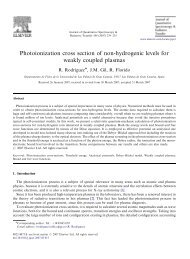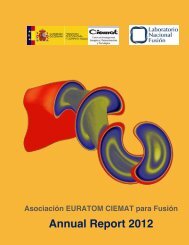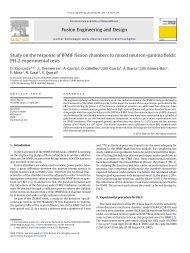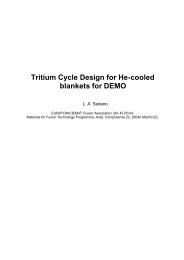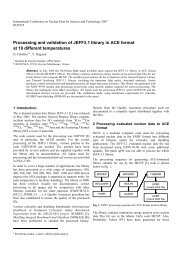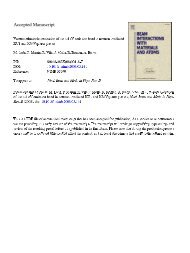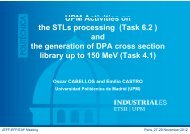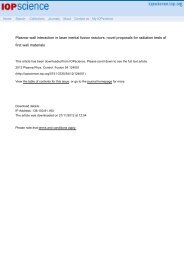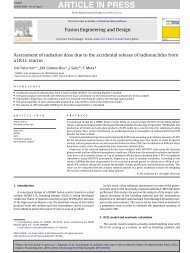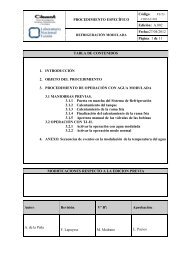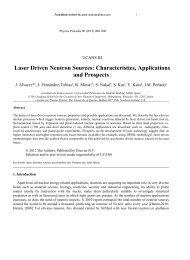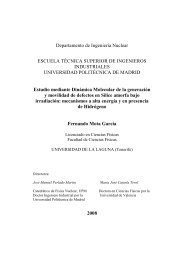ECRH / ECCD Scenarios on W7-X Stellarator - Ciemat
ECRH / ECCD Scenarios on W7-X Stellarator - Ciemat
ECRH / ECCD Scenarios on W7-X Stellarator - Ciemat
Create successful ePaper yourself
Turn your PDF publications into a flip-book with our unique Google optimized e-Paper software.
CWGM 4, Madrid, 20 - 22 October 2008<br />
<str<strong>on</strong>g>ECRH</str<strong>on</strong>g> / <str<strong>on</strong>g>ECCD</str<strong>on</strong>g> <str<strong>on</strong>g>Scenarios</str<strong>on</strong>g><br />
<strong>on</strong> <strong>W7</strong>-X <strong>Stellarator</strong><br />
N.B. Marushchenko<br />
with H. Maaßberg, Maa berg, Yu. Turkin, Turkin C.D. Beidler, V. Erckmann, J. Geiger,<br />
H.P. Laqua and <strong>W7</strong>-X Team<br />
Max-Planck-Institut für Plasmaphysik, EURATOM-Associati<strong>on</strong>,<br />
Greifswald, Germany<br />
1
Introducti<strong>on</strong><br />
C<strong>on</strong>tent<br />
Numerical tools for predictive modeling<br />
Low and moderate density plasma: X2 scenario<br />
High density plasma: O2 scenario<br />
High density plasma: X3 scenario?<br />
Net current c<strong>on</strong>trol<br />
Summary<br />
2
<strong>W7</strong>-X stellarator:<br />
Introducti<strong>on</strong><br />
large scale device with superc<strong>on</strong>ducting coils<br />
no ohmic transformer<br />
low-shear magnetic c<strong>on</strong>figurati<strong>on</strong> of Helias type with 5 periods<br />
Scientific objectives:<br />
steady state operati<strong>on</strong> with the reactor relevant parameters<br />
stable operati<strong>on</strong> with high-pressure plasma (up to β ~ 5%)<br />
good plasma c<strong>on</strong>finement<br />
explore the magnetic c<strong>on</strong>figurati<strong>on</strong> space<br />
- bootstrap current minimized for “high-mirror” c<strong>on</strong>figurati<strong>on</strong><br />
- neoclass. c<strong>on</strong>finement optimized for “standard” c<strong>on</strong>figurati<strong>on</strong><br />
divertor operati<strong>on</strong> with good density and impurity c<strong>on</strong>trol<br />
3
<str<strong>on</strong>g>ECRH</str<strong>on</strong>g> / <str<strong>on</strong>g>ECCD</str<strong>on</strong>g> scenarios<br />
X2-scenario is well tested and no troubles are expected<br />
O2-scenario can be performed by transiti<strong>on</strong> from X2-scenario<br />
operati<strong>on</strong> with <strong>on</strong>ly X3-scenario seems doubtful, but possible in<br />
combinati<strong>on</strong> with X2 / O2
<str<strong>on</strong>g>ECRH</str<strong>on</strong>g> tools:<br />
<str<strong>on</strong>g>ECRH</str<strong>on</strong>g> aims:<br />
plasma start-up and heating<br />
<str<strong>on</strong>g>ECRH</str<strong>on</strong>g> / <str<strong>on</strong>g>ECCD</str<strong>on</strong>g> scenarios<br />
10 Gyrotr<strong>on</strong>s 140 (104) GHz 1 MW each<br />
angle fr<strong>on</strong>t steering<br />
quasi-steady-state<br />
positive NBI<br />
current drive for the rotati<strong>on</strong>al profile tailoring<br />
feedback c<strong>on</strong>trol of the net plasma current<br />
c<strong>on</strong>figurati<strong>on</strong> c<strong>on</strong>trol in operati<strong>on</strong> with high β<br />
operati<strong>on</strong> with over-dense plasma: Bernstein waves<br />
(far future plans…)<br />
<str<strong>on</strong>g>ECRH</str<strong>on</strong>g><br />
negative NBI<br />
7
Numerical tools: ray tracing code<br />
TRAVIS: multi-bandle & multi-pass ray-tracing code<br />
works stand-al<strong>on</strong>e and coupled self-c<strong>on</strong>sistently with 1D transport code<br />
the anomalous dispersi<strong>on</strong> taken into account<br />
(the weakly-relativistic Hamilt<strong>on</strong>ian for tracing, Westerhof-Tokman model)<br />
fully-relativistic model for absorpti<strong>on</strong> & CD (for arbitrary distributi<strong>on</strong> functi<strong>on</strong>)<br />
<str<strong>on</strong>g>ECCD</str<strong>on</strong>g>: adjoint approach with momentum c<strong>on</strong>servati<strong>on</strong> taken into account<br />
(the package for arbitrary collisi<strong>on</strong>ality under development)<br />
dP/dV decomposed in c<strong>on</strong>tributi<strong>on</strong>s from trapped and passing electr<strong>on</strong>s<br />
energy range of electr<strong>on</strong>s resp<strong>on</strong>sible for absorpti<strong>on</strong> estimated<br />
package for quasi-optical technique under development<br />
(in collaborati<strong>on</strong> with IAP RAS)<br />
9
Geometry<br />
- Analysis<br />
- Diagnostics<br />
- Transport modeling<br />
g ik , V´, ιota, ‹…›<br />
Database<br />
- Analysis<br />
- Diagnostics<br />
- Transport modeling<br />
Equilibrium<br />
- Analysis<br />
- Diagnostics<br />
- Transport modeling<br />
Yu. Turkin<br />
Numerical tools: Transport Package<br />
Neoclassic transport<br />
Fluxes, E r , j BS<br />
- Analysis<br />
- Plasma current c<strong>on</strong>trol<br />
- Transport modeling<br />
Transport<br />
Equati<strong>on</strong>s:<br />
Evoluti<strong>on</strong> of<br />
n e, T e , T i , E r , j p<br />
Anomalous transport<br />
- Analysis<br />
- Transport modeling<br />
Sources & Sinks<br />
3d-Codes:<br />
<str<strong>on</strong>g>ECRH</str<strong>on</strong>g>, NBI, Pellets,<br />
Neutrals, Losses<br />
- Planning of experiments<br />
- Analysis<br />
- Transport modeling<br />
<str<strong>on</strong>g>ECCD</str<strong>on</strong>g>, NBCD<br />
Feedback C<strong>on</strong>trol,<br />
Current C<strong>on</strong>trol,<br />
Density C<strong>on</strong>trol,<br />
Heating C<strong>on</strong>trol:<br />
- Plasma c<strong>on</strong>trol<br />
- Transport modeling<br />
Development of TP implies development of modules needed<br />
for other activities; modules must be reusable <br />
Transport Package is a part of Software for <strong>W7</strong>-X<br />
10
Why neoclassical c<strong>on</strong>finement model<br />
Experience of <strong>W7</strong>-AS high-performance discharges<br />
Yu. Turkin<br />
P <str<strong>on</strong>g>ECRH</str<strong>on</strong>g> =1.2 MW in X2-mode; “electr<strong>on</strong> root”<br />
T e = 3 - 3.5 kev<br />
Experimental χ<br />
Neoclassical χ<br />
11
<str<strong>on</strong>g>ECRH</str<strong>on</strong>g> / <str<strong>on</strong>g>ECCD</str<strong>on</strong>g> scenarios<br />
X2-scenario is well tested and no troubles are expected<br />
O2-scenario can be performed by transiti<strong>on</strong> from X2-scenario<br />
operati<strong>on</strong> with <strong>on</strong>ly X3-scenario seems doubtful, but possible in<br />
combinati<strong>on</strong> with X2 / O2<br />
12
T e (0)<br />
[keV]<br />
Low and moderate densities: X2-scenario<br />
plasma start-up, <str<strong>on</strong>g>ECRH</str<strong>on</strong>g> / <str<strong>on</strong>g>ECCD</str<strong>on</strong>g> cw, up to 10 MW<br />
low densities, n e = 0.1 – 0.6 × 10 20 m -3 , high T e<br />
moderate densities, n e = 0.6 – 1.0 × 10 20 m -3 , high both T e and T i<br />
complete bootstrap current compensati<strong>on</strong><br />
30<br />
25<br />
20<br />
15<br />
10<br />
5<br />
0<br />
Yu. Turkin<br />
e-root<br />
P=2MW<br />
P=4MW<br />
P=8MW<br />
P=10MW<br />
0.1 0.4 0.7 1<br />
n e [ 10 20 m -3 ]<br />
χ e<br />
[m 2 /s]<br />
100<br />
10<br />
1<br />
0.1<br />
0.01<br />
neo<br />
Lackner-Gottardi<br />
anomalous<br />
0 0.1 0.2 0.3 0.4 0.5<br />
r eff [m]<br />
13
Single-pass absorpti<strong>on</strong>:<br />
Optimistic expectati<strong>on</strong>s!<br />
O2-scenario: O2-scenario:<br />
results of the density scan<br />
off-axis<br />
17
3 passes<br />
High densities: O2-scenario<br />
β=2% equlib. β=4% equlib.+0.12T<br />
T e > 4 keV is reached in the regi<strong>on</strong> of good absorpti<strong>on</strong> (see yellow regi<strong>on</strong>)<br />
Absorpti<strong>on</strong> rapidly increases for larger temperatures (absorpti<strong>on</strong> )<br />
Yu. Turkin<br />
! T<br />
2<br />
e<br />
18
Reduced magnetic field: X3<br />
“standard” c<strong>on</strong>figurati<strong>on</strong>, B ≈ 1.86 T :<br />
X3 at 140 GHz: HFS launch from the “triangular” plane<br />
can be supported by<br />
140 GHz, B = 1.67 T<br />
X3 stand al<strong>on</strong>e, P RF = 5 MW<br />
X2 / O2 at 104 GHz: LFS launch from the “bean-shaped” plane<br />
19
adjoint approach for <str<strong>on</strong>g>ECCD</str<strong>on</strong>g><br />
momentum c<strong>on</strong>servati<strong>on</strong><br />
collisi<strong>on</strong>less or collisi<strong>on</strong>al limits (with or without trapped particles)<br />
so far, the bootstrap current calculated w/o momentum c<strong>on</strong>servati<strong>on</strong><br />
new advanced model under development:<br />
momentum c<strong>on</strong>servati<strong>on</strong> & arbitrary collisi<strong>on</strong>ality<br />
Tasks:<br />
Net plasma current c<strong>on</strong>trol: theoretical models<br />
1. to check an ability of <str<strong>on</strong>g>ECCD</str<strong>on</strong>g> as counteracting tool<br />
2. to find an optimal scenario<br />
At the present moment, <strong>on</strong>ly preliminary results for the net current<br />
c<strong>on</strong>trol are obtained<br />
20
General c<strong>on</strong>diti<strong>on</strong>s:<br />
Net plasma current c<strong>on</strong>trol<br />
for both X2- and O2-scenarios: five beams 1 MW each<br />
B 0 = 2.53 T:<br />
LFS shift with off-axis X2- (w/o “electr<strong>on</strong> root”) and <strong>on</strong>-axis O2-depositi<strong>on</strong><br />
the O2-scenario, three passes are taken into account<br />
(2nd pass – reflecti<strong>on</strong> from the mirror, 3rd pass – reflecti<strong>on</strong> from the wall)<br />
choice of the density range:<br />
for X2-scenario: 0.1×10 20 < n e < 1.0×10 20 m -3<br />
for O2-scenario: 0.6×10 20 < n e < 2.2×10 20 m -3<br />
(absorpti<strong>on</strong> higher 90% after 3 passes)<br />
21
<str<strong>on</strong>g>ECCD</str<strong>on</strong>g> efficiency: density scan<br />
• X2: with launch angle for maximum efficiency<br />
• O2: launch angle defined by mirror <strong>on</strong> HFS<br />
22
Summarized <str<strong>on</strong>g>ECCD</str<strong>on</strong>g> profiles (five ( five beams, beams,<br />
P RF = 5 MW) MW<br />
n e (0) = 0.8×10 20 m -3 , Z eff = 1.5<br />
X2-scenario, off-axis:<br />
plasma is optically thick<br />
<str<strong>on</strong>g>ECCD</str<strong>on</strong>g> scales approx. as 1 / n e<br />
T e -dependence of <str<strong>on</strong>g>ECCD</str<strong>on</strong>g> efficiency<br />
is not str<strong>on</strong>gly pr<strong>on</strong>ounced<br />
O2-scenario, (almost) <strong>on</strong>-axis:<br />
plasma is optically “gray”<br />
(> 95% absorpti<strong>on</strong> after 3 passes)<br />
<str<strong>on</strong>g>ECCD</str<strong>on</strong>g> scales roughly as 1 / n e<br />
<str<strong>on</strong>g>ECCD</str<strong>on</strong>g> efficiency much more<br />
sensitive to T e<br />
X2: T e (0) ≈ 5.3 keV<br />
O2: T e (0) ≈ 6.7 keV<br />
23
Net plasma current c<strong>on</strong>trol for “standard” c<strong>on</strong>figurati<strong>on</strong><br />
density scan for 5 beams, P RF = 5 MW, β = 2%<br />
Ray-tracing + 1D transport<br />
modeling X2<br />
current drive<br />
X2-mode: <str<strong>on</strong>g>ECCD</str<strong>on</strong>g> c<strong>on</strong>trol of I bc is surely possible<br />
O2-mode: <str<strong>on</strong>g>ECCD</str<strong>on</strong>g> c<strong>on</strong>trol of I bc seems not reliable<br />
O2<br />
bootstrap current<br />
(apart of “high-mirror” c<strong>on</strong>figurati<strong>on</strong>)<br />
24
Summary & Outlook<br />
The different <str<strong>on</strong>g>ECRH</str<strong>on</strong>g> / <str<strong>on</strong>g>ECCD</str<strong>on</strong>g> scenarios analyzed with help of self-c<strong>on</strong>sistently<br />
coupled ray-tracing and 1D transport codes<br />
X2-scenario the main scenario for low and moderate densities,<br />
0.1 × 10 20 m -3 < n e < 1.0 × 10 20 m -3 → good c<strong>on</strong>finement, high temperatures<br />
multi-pass O2-scenario the main scenario for high densities,<br />
0.8 × 10 20 m -3 < n e < 2.0 × 10 20 m -3 → good c<strong>on</strong>finement, high temperatures<br />
net plasma current c<strong>on</strong>trol:<br />
for X2-scenario surely possible<br />
for O2-scenario reliable for the “high-mirror” c<strong>on</strong>figurati<strong>on</strong><br />
(but not for the “standard” and “low-mirror”)<br />
Improved tools for calculati<strong>on</strong> of <str<strong>on</strong>g>ECCD</str<strong>on</strong>g> and bootstrap current under<br />
development (parallel momentum c<strong>on</strong>servati<strong>on</strong> + arbitrary collisi<strong>on</strong>ality)<br />
Since L / R time scale is about tens sec<strong>on</strong>ds, time dynamic has to be studied:<br />
X2 → O2 transiti<strong>on</strong><br />
net plasma current & iota time evoluti<strong>on</strong> (island divertor topology)<br />
25
CWGM 4, Madrid, 20 - 22 October 2008<br />
Thanks for attenti<strong>on</strong><br />
26
28<br />
Diffusi<strong>on</strong> model<br />
!<br />
!<br />
!<br />
!<br />
!<br />
!<br />
!<br />
!<br />
!<br />
!<br />
!<br />
!<br />
!<br />
!<br />
!<br />
!<br />
!<br />
!<br />
!<br />
!<br />
!<br />
!<br />
!<br />
!<br />
!<br />
!<br />
!<br />
!<br />
!<br />
!<br />
!<br />
!<br />
!<br />
!<br />
!<br />
"<br />
!<br />
T<br />
T<br />
n<br />
Q<br />
n<br />
D<br />
i<br />
e<br />
Q<br />
Q<br />
Q<br />
T<br />
T<br />
D<br />
T<br />
E<br />
z<br />
n<br />
n<br />
D<br />
T<br />
n<br />
Q<br />
T<br />
T<br />
D<br />
T<br />
E<br />
z<br />
n<br />
n<br />
D<br />
n<br />
an<br />
an<br />
an<br />
an<br />
an<br />
an<br />
neo<br />
an<br />
neo<br />
r<br />
neo<br />
r<br />
neo<br />
#<br />
+<br />
$<br />
%<br />
=<br />
$<br />
%<br />
=<br />
#<br />
=<br />
+<br />
=<br />
#<br />
+<br />
#<br />
=<br />
#<br />
&<br />
&<br />
'<br />
(<br />
)<br />
)<br />
*<br />
+ $<br />
+<br />
,<br />
,<br />
-<br />
.<br />
/<br />
/<br />
0<br />
1<br />
%<br />
$<br />
%<br />
=<br />
&<br />
&<br />
'<br />
(<br />
)<br />
)<br />
*<br />
+ $<br />
+<br />
,<br />
,<br />
-<br />
.<br />
/<br />
/<br />
0<br />
1<br />
%<br />
$<br />
%<br />
=<br />
#<br />
2<br />
5<br />
,<br />
,<br />
,<br />
,<br />
,<br />
, 22<br />
21<br />
12<br />
11<br />
Anomalous heat diffusivity at the edge <strong>on</strong>ly.<br />
e<br />
an<br />
n<br />
/<br />
1<br />
!<br />
"<br />
#<br />
D 22 neoclassical heat diffusivity<br />
Yu. Turkin
Low and moderate densities: X2-scenario<br />
Ray-tracing results for the RF beam from the port AC1:<br />
n e = 0.6 × 10 20 m -3 , T e = 5.2 keV (from 1D transport code),<br />
“standard” c<strong>on</strong>figurati<strong>on</strong>, B = 2.53 T, = 2%<br />
29
Low and moderate densities: X2-scenario<br />
near the cyclotr<strong>on</strong> res<strong>on</strong>ance, the anomalous dispersi<strong>on</strong> effects<br />
are significant<br />
power is absorbed by the bulk electr<strong>on</strong>s<br />
31
High densities: O2-scenario<br />
the anomalous dispersi<strong>on</strong> effects are negligible<br />
power is absorbed not <strong>on</strong>ly by the bulk but also by suprathermal electr<strong>on</strong>s<br />
34



